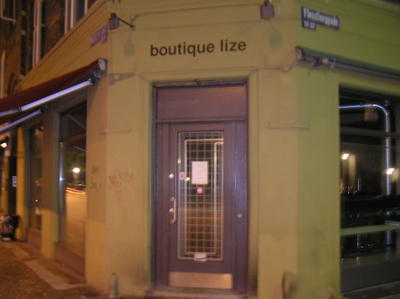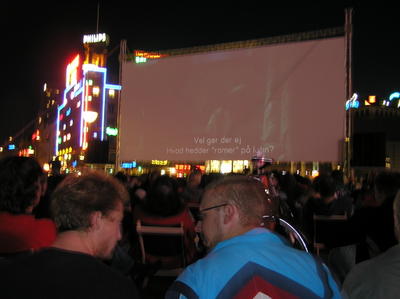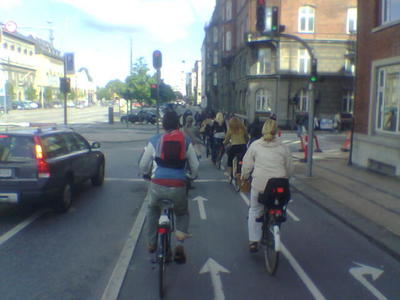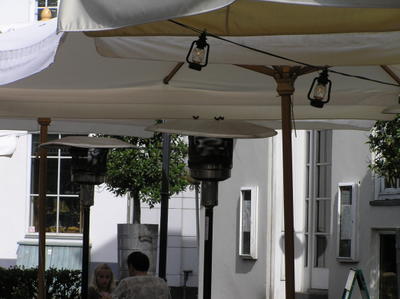Closing Time In Copenhagen (Part 4) - Always Look on the Bright Side of Life...
by Tim Anderson (timothyanderson2005@gmail.com)
Here's the latest installment of this soon finishing series, perhaps slightly more opinionated than the previous ones (Closing Time in Copenhagen - Part 1, Part 2, Part 3).
I could easily make Copenhagen out to be a little slice of northern utopia - there are loads of unique and fascinating things about the place. It is equally easy to go on the attack and complain. Easy, because by way of being the biggest city in Denmark, Copenhagen is conferred a number of unavoidable expectations, yet it is still a small city by the standard of large, international cities. This puts Copenhagen in a challenging position.
With a population over a million (counting the carefully fairly managed urban sprawl surrounding it) there is really no other realistic choice of a place to live in Denmark for those with a taste for urban living - though those living in Aarhus, Denmark's second largest city, may disagree. But Aarhus is less than half the size of Copenhagen, so it really is something different. For my taste, the consequence of all of this is having to accept that Copenhagen is a great city, though a little less dynamic place than I would wish it to be.
In any major city, change and reinvention over time is a natural occurrence, propelled forward by a large, constantly shifting population. Copenhagen can seem a little slow on the uptake to this end. One is tempted to blame the city’s residents for so passively accepting this state of affairs, which is really not fair to say, and wish there was a greater level of ethnic diversity to help things along. But Copenhagen is not a very big city at all, by European standards, and it doesn't have the same sort of recent colonial past of places like Holland, England and France that helps bring in the immigrants - so ethnic diversity is somewhat lacking relative to other spots in Europe for good reason.
In a place like Canada, for example, there are four cities of more than one million people (Calgary, Vancouver, Montreal and Toronto), and at least three of them could be said to have a set of characteristics that would make them ‘major global cities’ (sorry, Calgary…). This means that in Canada, unlike in a small country as Denmark is, one need not give up on urban life altogether if one is dissatisfied with how it is to live in one particular place (though one may have to move a fair distance).
Take the evident lack of diversity among restaurants and cafes in Copenhagen. Try to find a restaurant or café willing to be a little more experimental than to offer more interesting seating arrangements than a bunch of square/rectangle tables and hard wooden chairs, and one quickly runs short of options. There are a few, just not enough - in my opinion.
Live in large cities like London or Berlin, and a constant flow of new bars and cafes opening and closing every week means there is always a new place to try. Not so in Copenhagen. Worse, some of the best places in Copenhagen don’t even bother opening on Mondays and Tuesdays - the good ones that do often close around midnight. And a good number of the cafes also close on Sunday – the very day when there is the most time to actually go out and enjoy them! This doesn’t say much for the residents of Copenhagen’s persistence and determination to make the most of the 7-day week.
Tuesday night at Boutique Lize - waiting for the weekend.
The restaurant culture is also somewhat underdeveloped. Sushi restaurants have finally arrived, but eight years after taking firm hold in cities like London. There are a few Indian, Thai and Mexican restaurants - a few of the Thai ones are fantastic, my Indian friends claim the Indian ones could be better (though a couple are quite good), the Mexicans I know here refuse to acknowledge that the Mexican restaurants even serve Mexican food. I never did find an authentic Chinese restaurant. And so on. I can say there are at least a small handful of absolutely outstanding Italian pizza places (the rest are by-in-large poor Italian knock-offs run by Turks).
But don’t get me wrong – all of this is not to say that Copenhagen is a bad city, a boring city, or an inadequate city. In spite of it's limitations, Copenhagen has an astounding capacity to suprise. I can note two example from the past week alone.
The other night to kick off the Copenhagen's International Film Festival, Monty Python’s Life of Brian was shown in the open air square in front of city hall. Pretty cool. And every summer there is a small film festival where recent blockbusters are shown outdoors for free in various parks and open spaces around the city. These are moment when heading home late at night amongst a swarm of hundreds of bicycles, you really feel you are part of something special, a happy little community.
Always look on the bright side of life...
A night later I found myself sitting in the beautiful Ostedsparken in the centre of town, a large public park with a big sunken lake in its centre, surrounded by trees and grass slopes just perfect for sitting in the sun in the summer. Only this night, the feature was a free sound and laser show. The lasers were shone out over the water along with steam pumped from various miniature cannons around the lake, while a live dj provided cool ambiant electronic music broadcast silently around the park heard through headphones provided for free at the park entrance. No deposit, no identification, no nothing to borrow those - just simple, old-fashioned trust that each person would return them when they left. The show went on until after midnight.
Smoke on the water, lasers in the sky and music in the air...
Much of the action in Copenhagen takes place off of the streets, because Danes do know how to have fun behind closed doors. Danes love private parties.
The candles get lit year-round for cosy, quiet little dinner evenings that often stretch late into the night and involve the consumption of loads of beer and wine. Some are not so quiet. Wander around Copenhagen on a Friday or Saturday night and late into the night you are likely to hear music coming through the windows on at least a few apartment on almost any street. Neighbours are powerless to interfere - if one wants to have a party in their apartment, the only tradition is to put a small note in the stairwell a few days in advance warning the neighbours there will be some noise (and possibly inviting them if it is a large enough party). If the police are called, the only thing they will do is ask that the party be moved indoors (if it is outside), and that the windows be closed (if it is inside). Otherwise, the show can continue as long as desired. In truth the police are rarely, if ever, called anyway.
Denmark also happens to be one of the most liberal countries with regards to the sale of alcohol. It has never been a problem getting alcohol day or night - even if most of the best places close early during the week. On weekends especially, there is always an option available if one wishes to keep drinking through the night - even it the hour has reached 5, 6, or even 7 in the morning. Even on a Monday or Tuesday, somewhere in the city a bar is always open for business (though many of them one would not want to set foot inside), while kiosks sell beer and spirits from the early morning to late into the night.
Probably a more fruitful lens to view Copenhagen through is as a major city that has improbably managed to maintain a certain degree of small-town charm.
Examples are numerous. I have never found a major city where so many baby carriages, pregnant woman and kids are visible - a remark repeated by countless newcomers to the city. Copenhagen is an astonishingly family-friendly city, with it's ample parks and quiet streets.
It is impossible to get stuck in a Copenhagen traffic jam - because there are none!! In fact, there is hardly any traffic at all for a city of Copenhagen’s size. People cycle, take trains, the metro, but the car remains the transportation choice of last resort – an extremely flat terrain, good city planning that includes bicycle lanes lining virtually every street, expensive fuel and a tax on new cars that wildly inflates their price (basically doubling it in comparison to surrounding countries!) has ensured this.
It is somewhat reassuring to see countless shops closing for two or three weeks in the summer while their owner’s vacation - they really are the small, un-corporate operations that they seem.


Closed for summer vaction ('sommer ferie lukket').
If there is one universal complaint about life in a small town, it is the tiny space separating the present from the past (and the future). In any place with a relatively static population, mistakes and embarrassments are rarely forgotten entirely over time. This could also describe life in Copenhagen, almost, since as the only major city in Denmark, Copenhagen is the one place where most return to again and again. So the past is never very distant here.
In wandering around Copenhagen, one continually and unexpectedly stumbles across it - long-lost friends, former classmates, ex-colleagues, old teachers, former lovers, ex-boyfriends and girlfriends, and so forth. Talk for a while, and one often discovers countless unpredictable connections that link friends, family, and colleagues and so forth together. It happens continually. Knowing this demands an extra level of maturity from those living here – one must get used to living with any mistakes, poor choices and old disagreements from the past (and the distinct possibility that you may already know the person you ex-girlfriend or boyfriend is now dating). You really can’t run away without leaving the country – even retreating to the countryside is hardly any guarantee. Everyone seems to have ties to Copenhagen in one way or another.
It is indeed something special about life here, something that distinguishes Copenhagen from many other major cities where it is much easier for a person to become another anonymous face in the crowd, or disappear outright. But what kind of enthusiastic urban-dweller wants to do that anyway?
 RSS Feed
RSS Feed  Twitter
Twitter 





